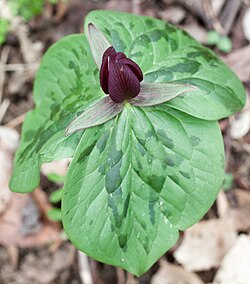Trillium sessile
| Trillium sessile subsp. var. | Toad shade, Toadshade | |||||||||||||||||||||||||||||||||||||||||||||||||||||||
|---|---|---|---|---|---|---|---|---|---|---|---|---|---|---|---|---|---|---|---|---|---|---|---|---|---|---|---|---|---|---|---|---|---|---|---|---|---|---|---|---|---|---|---|---|---|---|---|---|---|---|---|---|---|---|---|---|

|
|
| ||||||||||||||||||||||||||||||||||||||||||||||||||||||
| ||||||||||||||||||||||||||||||||||||||||||||||||||||||||
Trillium sessile (Toadshade or Sessile-flowered wake-robin) is a perennial spring wildflower native to the central part of the eastern United States and the Ozarks. It is a small trillium (rarely over 9 cm tall). Toadshade can be distinguished from other trilliums by its single foul smelling, stalkless, flower nestled in the middle of its three leaves. The three maroon petals, maintain a "closed" posture throughout its presence, the petals are occasionally pale green. The leaves are sometimes, but not always mottled with shades of light and dark green. Its species name comes from the Latin word sessilis which means low sitting, and refers to its stalkless flower.
T. sessile is most common in rich moist woods but also can be found in rich forests, limestone woods, flood plains, along fence rows. It is persistent under light pasturing.[1] The foul smelling flowers attract its primary pollinators, flies and beetles.[2] The flowers are present from April-June. This plant is clump forming from a thick rhizome. The above ground parts of the plant die back by mid-summer, but may persist longer in areas that do not completely dry out.
| Standard Cyclopedia of Horticulture |
|---|
|
Trillium sessile, Linn. Strong-growing, 1 ft. or less high: lvs. broadly ovate or rhomboidal, acute, more or less spotted: fls. sessile in the whorl of lvs., small, purple or greenish, the petals narrow and acute. Woods, Pa. to Minn., Ark., and Fla.—Variable. Var. giganteum, H. & A. (var. angustipetalum, Torr.). Similar to var. californicum, but the lvs. somewhat petiolate and the petals narrower. Calif. and Ore. Apparently not in the trade. The forms of T. sessile appear to be the only trilliums native to Calif. except T. ovatum. Var. californicum, Wats. (var. giganteum, Torr.). Much stouter, the lvs. often 6 in. long and spotted, and the petals sometimes 4 in. long: fls. purple, rose-color, or white, the petals rhombic-ovate or narrower. Calif. and Ore. Var. Nuttallii, Wats. (T. viridescens, Nutt.). Lvs. pubescent beneath, as also the upper part of the st.: petals linear-lanceolate, purplish green with brown base. Ark. Var. rubrum, Hort. A form of var. californicum, with fls. deep red-purple. Var. Wrayi, Wats. (T. discolor, Wray). Petals spatulate-obtuse, 1 in. long, greenish. Ga. CH
|
Cultivation
- Do you have cultivation info on this plant? Edit this section!
Propagation
- Do you have propagation info on this plant? Edit this section!
Pests and diseases
- Do you have pest and disease info on this plant? Edit this section!
Species
Gallery
-
Colony of T. sessile
-
photo 1
-
photo 2
-
photo 3
References
- Standard Cyclopedia of Horticulture, by L. H. Bailey, MacMillan Co., 1963
External links
- w:Trillium sessile. Some of the material on this page may be from Wikipedia, under the Creative Commons license.
- Trillium sessile QR Code (Size 50, 100, 200, 500)

